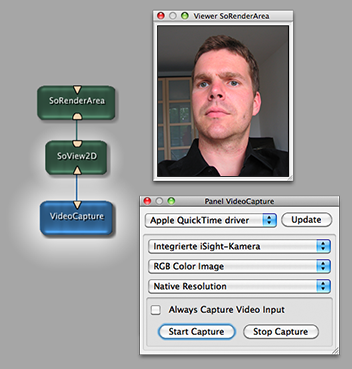VideoCapture¶
- MLModule¶
genre
author
package
dll
definition
see also
keywords
Purpose¶
The VideoCapture module provides a bridge to the video input capabilities of the operating system. Depending on the back-end used for interfacing with the operating system, different video input devices are supported. Currently, there are back-ends for the following operating systems:
macOS: The QuickTime AVFoundation back-end interfaces with all video hardware that conforms to the Universal Video Class (UVC) standard (like most of the current web-cams with USB or FireWire)
Windows, Linux: The OpenCV back-end interfaces with all video devices supported by OpenCV on that operating system

Usage¶
Connect an ML image input connector to the output connector of the module to access the images.
Details¶
The driver back-ends are derived from the VCVideoCaptureInterface class and are dynamically detected and loaded. Custom drivers can be developed and will be made available by the VideoCapture module if registered to the run-time type system.
On macOS, the QuickTime AVFoundation driver uses multithreading to offload video grabbing and post-processing to an own thread. 24Bit RGB, 8Bit grayscale as well as 16Bit grayscale images are supported as long as the video hardware is able to acquire those images.
The OpenCV back-end available to Windows and Linux supports only 24Bit RGB images, currently. Since OpenCV provides only basic camera control, the detection and selection of video input devices is limited. The module will always expose two camera input devices.
Output Fields¶
output0¶
- name: output0, type: Image¶
The module provides one image output connector to access the video stream in form of an ML image.
outDriverAccess¶
- name: outDriverAccess, type: MLBase¶
The module exposes direct access to the video driver back-end via this base field.
Parameter Fields¶
Field Index¶
|
|
|
|
|
|
|
|
|
|
|
|
|
|
|
|
Visible Fields¶
Update¶
- name: updateDriversList, type: Trigger¶
Updates the list of known drivers. Use this button if you add another device driver at run-time
Driver¶
- name: driver, type: String, default: OpenCV driver¶
Currently selected device driver
Input Source¶
- name: inputSource, type: String¶
Currently selected video input source
Video Format¶
- name: videoFormat, type: String¶
Currently selected video input format
Video Frame Size¶
- name: videoFrameSize, type: String, default: Default Resolution¶
Currently selected video frame size
Always capture video input¶
- name: autoCapture, type: Bool, default: FALSE¶
Always capture video input (starts automatically)
Start Capture¶
- name: startCapture, type: Trigger¶
Manually start video capture
Stop Capture¶
- name: stopCapture, type: Trigger¶
Manually stop video capture
Auto Exposure¶
- name: autoExposure, type: Bool, default: TRUE¶
Exposure¶
- name: exposure, type: Double, default: 0¶
Gain¶
- name: gain, type: Double, default: 0¶